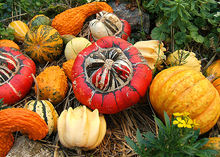Cucurbitales
| Cucurbitales Temporal range: 107–0 Ma Early Cretaceous – Recent |
|
|---|---|
 |
|
| Scientific classification | |
| Kingdom: | Plantae |
| Clade: | Angiosperms |
| Clade: | Eudicots |
| Clade: | Rosids |
| Clade: | Fabids |
| Order: |
Cucurbitales Juss. ex Bercht. & J.Presl |
| Families | |
The Cucurbitales are an order of flowering plants, included in the rosid group of dicotyledons. This order mostly belongs to tropical areas, with limited presence in subtropic and temperate regions. The order includes shrubs and trees, together with many herbs and climbers. One major characteristic of the Cucurbitales is the presence of unisexual flowers, mostly pentacyclic, with thick pointed petals (whenever present). The pollination is usually performed by insects, but wind pollination is also present (in Coriariaceae and Datiscaceae).
The order consists of roughly 2600 species in eight families. The largest families are Begoniaceae (begonia family) with around 1500 species and Cucurbitaceae (gourd family) with around 900 species. These two families include the only economically important plants. Specifically, the Cucurbitaceae (gourd family) include some food species, such as squash, pumpkin (both from Cucurbita), watermelon (Citrullus vulgaris), and cucumber and melons (Cucumis). The Begoniaceae are known for their horticultural species, of which there are over 130 with many more varieties.
The Cucurbitales are an order of plants with a cosmopolitan distribution, particularly diverse in the tropics. Most are herbs, climber herbs, woody lianas or shrubs but some genera include canopy-forming evergreen lauroid trees. Members of the Cucurbitales form an important component of low to montane tropical forest with greater representation in terms of the number of species. Although not known with certainty the total number of species in the order, conservative estimates indicate about 2600 species worldwide, distributed in 109 genera. Compared to other flowering plant orders, the taxonomy is poorly understood due to their great diversity, difficulty in identification, and limited study.
...
Wikipedia
